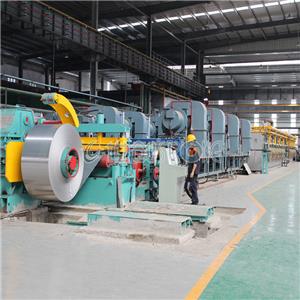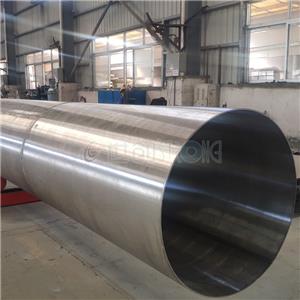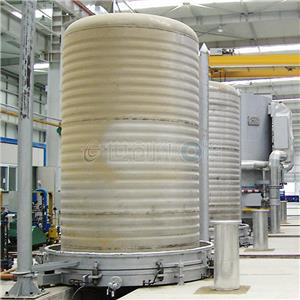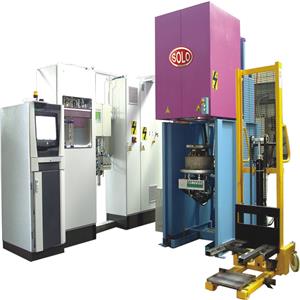Practical knowledge: Principles and functions of ammonia decomposition furnace
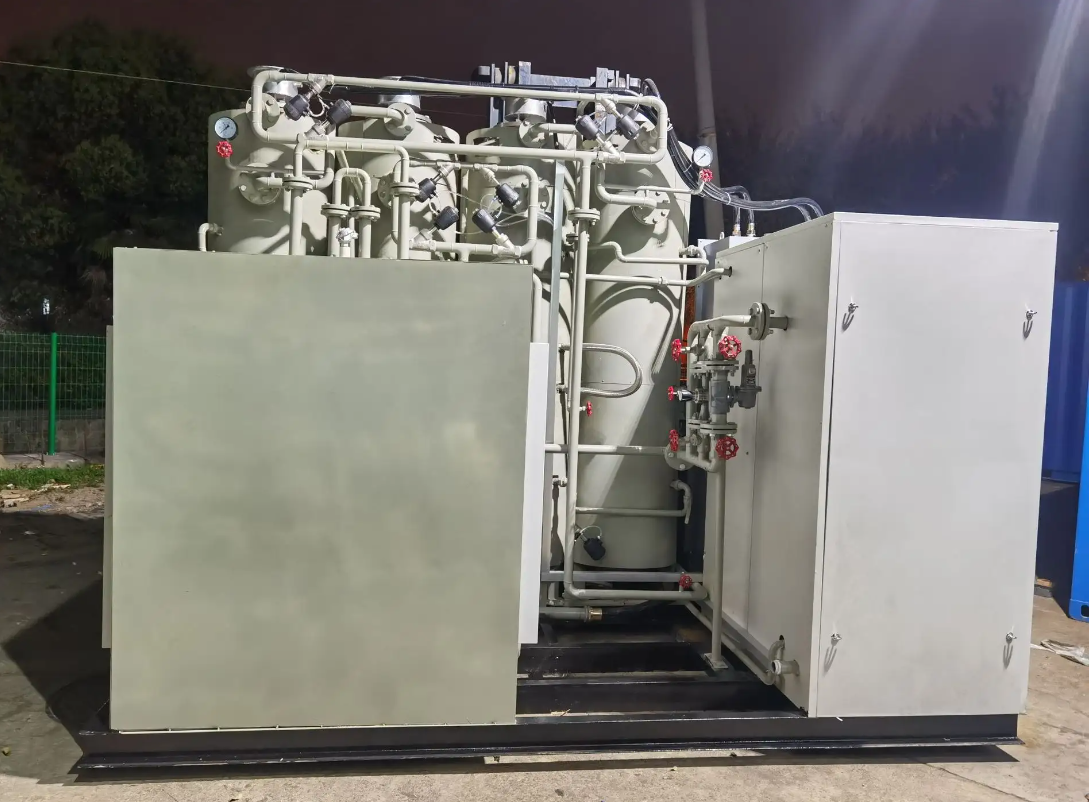
The working principle :
The ammonia is decomposed under the action of a nickel-based catalyst
Liquid ammonia is heated to 800-850 ℃, and under the action of nickel-based catalyst, ammonia is decomposed, and hydrogen nitrogen gas containing 75%H2 and 25%N2 can be obtained. The equipment consists of an inner tank box, a furnace tank arranged in the inner chamber of the inner tank box, passing through at least two gas pipes on the inner tank box, and the gas pipe is connected with the inner chamber of the inner tank box, the inner chamber is provided with a plurality of central pipes, the central pipe is provided with an electric heating wire, the wall of the inner tank box at both ends of the central pipe is provided with a plurality of mounting holes, and the mounting holes are fixed in the sleeve. The two ends of the center pipe are respectively inserted into the sleeve pipe, and the outer mouth of the sleeve pipe is provided with a sleeve cover.
Theoretical principle
Liquid ammonia is heated to 800-850 ℃, and under the action of nickel-based catalyst, ammonia is decomposed, and hydrogen nitrogen gas containing 75%H2 and 25%N2 can be obtained
Main component
The ammonia decomposition furnace comprises an inner tank box, a furnace tank arranged in the inner chamber of the inner tank box, and at least two gas pipes passing through the inner tank box, and the gas pipe is connected with the inner chamber of the furnace tank, the inner chamber of the inner tank box is provided with a plurality of central pipes, the central pipe is provided with an electric heating wire, and the wall of the inner tank box at both ends of the central pipe is provided with a plurality of mounting holes. The sleeve is fixed in each mounting hole, both ends of the center pipe are respectively inserted in the sleeve pipe, and the sleeve cover is provided on the outer mouth of the sleeve. When the heating wire is burned out, the heating wire can be replaced directly by removing the center tube from the inner tank box, and the replacement process is simple and fast.
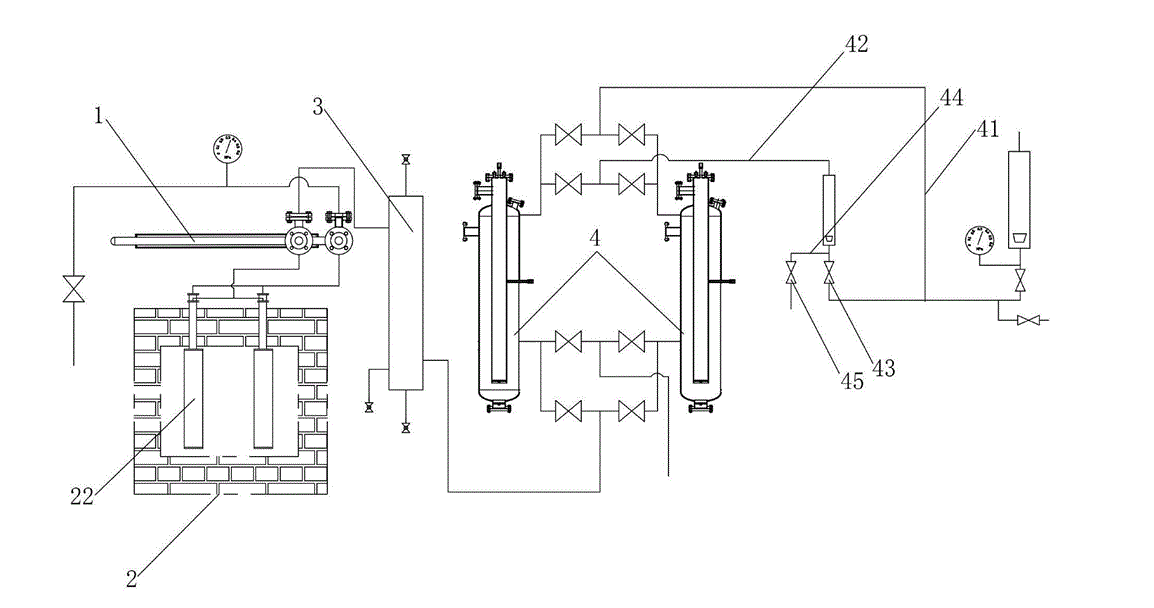
Process description
Using liquid ammonia as raw material, after ammonia cracking, 2.64Nm gas mixture can be prepared per kilogram of liquid ammonia cracking, which contains 75% hydrogen and 25% nitrogen. The resulting gas contains less impurities (about 2 grams/cubic meter of water vapor in the impurities, about 1000ppm of residual ammonia), and then through the molecular sieve (United States UOP) adsorption purifier, the dew point of the gas can be reduced to below -60C, and the residual ammonia can be reduced to below 3PPM.
Ammonia cracking hydrogen production furnace can be used for bright annealing of nonferrous metals, silicon steel, chromium steel and stainless steel and other metal materials and parts, decarbonization of silicon steel sheet, copper and iron based powder metallurgy sintering, hydrogen burning of metal parts of electric vacuum devices, protective sintering and sealing of semiconductor devices, palladium alloy film diffusion purification of hydrogen raw gas.
The raw material ammonia is easy to obtain, the price is low, and the raw material consumption is less. Ammonia cracking to produce protective gas has the advantages of less investment, small volume and high efficiency
How hydrogen production works
Ammonia (gaseous) at a certain temperature, under the action of a catalyst (Z204) cracking into 75% hydrogen and 25% nitrogen, and absorb 21.9 kcal heat, the main reaction is:
2NH3 -- 3H2+N2 -- 21.9 kcal
The whole process is endothermic expansion reaction, increasing the temperature is conducive to ammonia cracking, and it is also a reaction of volume expansion, reducing the pressure is conducive to the decomposition of ammonia, and the ammonia decomposition hydrogen production equipment is the best state to use.
How purification works
When the hydrogen produced by the ammonia decomposition hydrogen production equipment is qualified, it is then entered into the hydrogen purification for further purification. The purity of the cracked hydrogen is very high, and the volatile impurities are only a small amount of residual ammonia and water, so it is only necessary to remove a small amount of residual ammonia and water to obtain a high purity gas.
Variable-temperature adsorption technology was used for gas purification. Variable temperature adsorption (TSA) technology is a gas separation and purification process based on the different adsorption properties of gas molecules on the internal surface of adsorbent (porous solid substance) at different temperatures. Adsorption of impurity gas at room temperature, desorption of impurity gas at heating,
The surface of the molecular sieve is full of micropores, at normal temperature and pressure can be adsorbed equivalent to 20% of its own weight (static adsorption of water and impurities), and at a temperature of about 350 ° C, it can be completely regenerated, and switched every 24 hours to obtain a product gas with qualified purity and impurity content.
The adsorption tower is used alternately in parallel with two towers, which can realize continuous gas supply.
The role of Ammonia Crackers
An ammonia cracker is a device that uses heat to break down ammonia (NH3) into hydrogen (H2) and nitrogen (N2). This process is called ammonia cracking, or ammonia dissociation.
Ammonia crackers are used in a variety of industries, including:
Heat treatment: Ammonia cracking is a common way to generate hydrogen for use in heat treatment furnaces. Hydrogen is a reducing agent, which means it can remove oxygen from metals. This makes it ideal for annealing, brazing, and other heat treatment processes that require a reducing atmosphere.
Annealing: Ammonia cracking can also be used to generate hydrogen for use in annealing furnaces. Annealing is a heat treatment process that softens metals and improves their ductility. Hydrogen is a good choice for annealing because it does not react with the metal and does not leave any harmful residues.
Sintering: Ammonia cracking can be used to generate hydrogen for use in sintering furnaces. Sintering is a process that uses heat and pressure to bond powdered materials together. Hydrogen is a good choice for sintering because it does not react with the materials and does not leave any harmful residues.
Metal production: Ammonia cracking is used to produce hydrogen for use in the production of metals such as steel, aluminum, and titanium. Hydrogen is used in these processes to remove impurities from the metals and to create a desired microstructure.
Ammonia crackers are typically made of steel or stainless steel. They are equipped with a furnace, a catalyst, and a condenser. The furnace heats the ammonia to a high temperature, the catalyst breaks down the ammonia into hydrogen and nitrogen, and the condenser cools the gas mixture and separates the hydrogen and nitrogen.
Ammonia crackers are a versatile and efficient way to generate hydrogen. They are used in a variety of industries and are essential for the production of many metals and materials.
Here are some additional details about ammonia crackers:
The ammonia cracking process is exothermic, meaning that it releases heat. This heat can be used to preheat the ammonia or to power other processes.
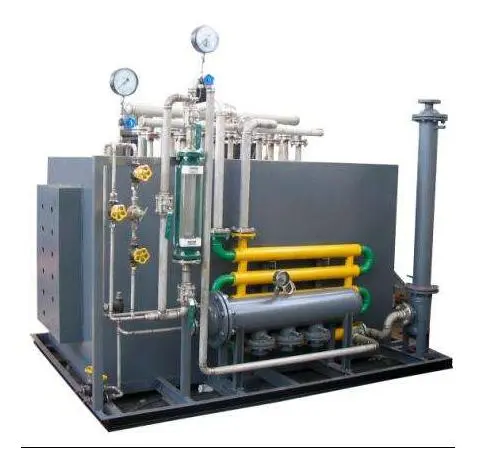
Ammonia crackers can be operated continuously or batchwise. Continuous operation is more efficient, but batch operation is more flexible.
The size of an ammonia cracker depends on the amount of hydrogen that is needed. Small ammonia crackers can generate a few cubic meters of hydrogen per hour, while large ammonia crackers can generate hundreds of cubic meters of hydrogen per hour.
Ammonia crackers are relatively inexpensive to operate. The cost of the ammonia is the main cost factor.
Ammonia crackers are safe to operate. However, they do produce some hazardous emissions, such as nitrogen oxides and ammonia. These emissions must be controlled to meet environmental regulations.
Overall, ammonia crackers are a safe and efficient way to generate hydrogen. They are used in a variety of industries and are essential for the production of many metals and materials.

